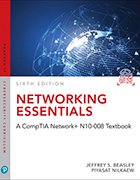An introduction to twisted-pair cable wiring
This excerpt from 'Networking Essentials: A CompTIA Network+ N10-008 Textbook' provides an overview of twisted-pair network cables and acts as a study tool for the exam.
Network cables, which interconnect devices together in a network, facilitate communication and data sharing between devices. Cables are a vital part of the overall network design.
"A network technician or engineer needs to have a good understanding of how physical layer cable is being used and its specific application," wrote co-authors Jeffrey Beasley and Piyasat Nilkaew in Networking Essentials: A CompTIA Network+ N10-008 Textbook from Pearson.
Prospective networking professionals should recognize the different types of network cables available for use, such as coaxial, fiber optic and twisted pair -- the most common type of network cable. Twisted wires were originally invented by Alexander Graham Bell in 1881 to enable communication between telephones. Enterprise network professionals continue to use modern upgrades of twisted-pair cable wiring, which remain the most popular type of Ethernet connectivity wiring.
Network professionals have the option of two types of twisted-pair cables: shielded twisted pair (STP) and unshielded twisted pair (UTP). STP cables mainly differ from UTP in that foil shields wrap around the STP wires to add insulation and protection. STP cables offer faster data transfer rates and are less prone to noise and crosstalk. But network professionals typically prefer to use UTP cables because they are less costly and easier to configure.
UTP cables aren't inadequate, however. Networking cable categories specify the way in which cables operate. For example, Cat5e, one of the most common types of twisted-pair cable wiring, specifies that data can transfer as far as 100 meters at speeds of up to 1 gigabit per second. Most enterprise networks use Cat5 or Cat5e cables in their configuration. But Cat6 twisted-pair cables, an advancement of Cat5e cables, improve network performance, Beasley and Nilkaew wrote, adding that students who plan to take the CompTIA Network+ exam should understand this fact.
Candidates who take CompTIA's Network+ N10-008 certification exam will likely encounter questions related to twisted-pair cables on the test, and many network professionals will use twisted-pair cable wiring in their careers. It's important for aspiring professionals to understand the ins and outs of twisted-pair network cables, whether they work with wired or wireless networks.
"If you're going to go into the world of networking, you've got to know all facets of it. Wireless is a part, but the wired systems are equally just as important," Beasley said.
Below is an excerpt titled "Physical Layer Cabling: Twisted-Pair" from Beasley and Nilkaew's book. The chapter discusses the different types of twisted-pair cables, how to use twisted-pair wiring to configure an enterprise network, and how to troubleshoot and terminate them.
Check out Networking Essentials: A CompTIA Network+ N10-008 Textbook
Click here to read Chapter 2, "Physical Layer Cabling: Twisted-Pair."








